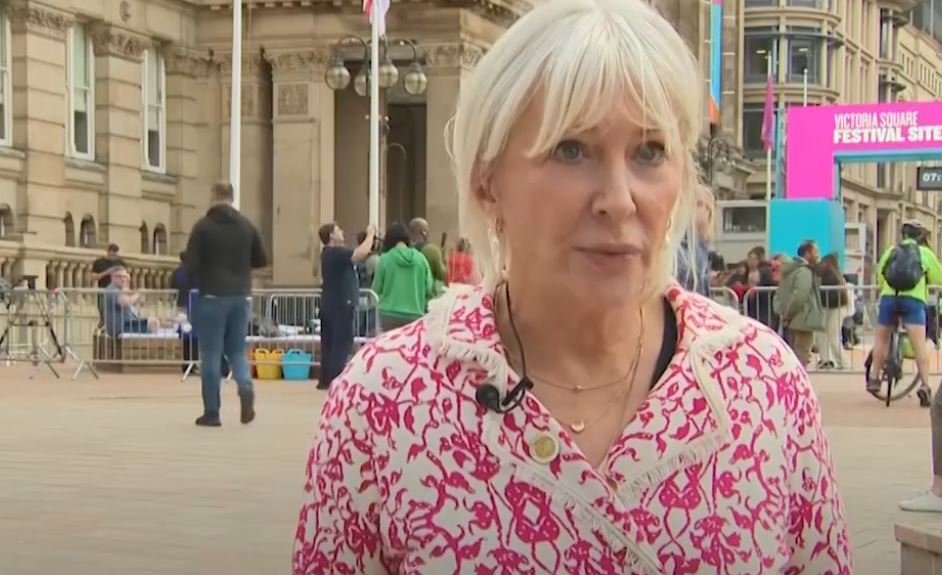
In recent months, Nadine Dorries has drawn attention for something much more personal—her dramatic weight loss at the age of 68—rather than a scathing political remark. She went from a UK size 16 to a toned size 10, losing 42 pounds and several dress sizes in the process. She attributes this to the GLP-1 medication Mounjaro, a mindful diet, and a consistent dedication to exercise. Although Dorries adds her distinctively British candor, the story is remarkably similar to many of the modern reinvention arcs we’ve seen among celebrities.
Dorries acted after receiving several calls from her doctor alerting her to high cholesterol and pre-diabetes. She acknowledged that she wasn’t searching for shortcuts, but she also acknowledged that she wasn’t above using tools. Urgency, not vanity, drove the decision to try Mounjaro, a medication commonly used to treat type 2 diabetes. These injections have become a potent tool in contemporary metabolic medicine due to their exceptional ability to reduce appetite and stabilize blood sugar. However, there is a lot of controversy surrounding their off-label use.
Nadine Dorries – Weight Loss Profile
| Name | Nadine Vanessa Dorries (née Bargery) |
|---|---|
| Age | 68 |
| Birthplace | Liverpool, England |
| Occupation | Former Politician, Author, Commentator |
| Notable Roles | Secretary of State for Digital, Culture, Media and Sport |
| Parliamentary Career | MP for Mid Bedfordshire (2005–2023) |
| Key Transformation | Lost 42 pounds (3 stone) at age 68 |
| Weight Loss Method | Mounjaro injections, mindful eating, regular exercise |
| Size Change | UK 16 to UK 10 |
| Primary Motivation | Pre-diabetic diagnosis and high cholesterol |
| Public Statement | “It’s not for wimps, but it’s worth it.” |
Dorries saw her body change as a result of months of regular use. Her confidence returned, her skin tone brightened, and her health metrics significantly improved. She was able to restore equilibrium to her lifestyle by integrating medication with mindful eating, as well as a renewed emphasis on walking and stretching. She has, however, been candid about how difficult it is to sustain results. She gained a few pounds back after stopping the injections, but she stabilized through new habits, which many dieters view as a success.
Dorries caused a stir when she mentioned her Mounjaro supplier live on air during a now-famous This Morning interview. Ben Shephard, the host, abruptly interrupted her, highlighting how delicate this subject has grown. Dorries had nothing to sell. She only wanted to emphasize how responsive the process had been, mentioning that after completing an online health form, she had received two follow-up calls from a doctor. She described it as “extremely reassuring.” However, in the media landscape of today, even transparency can be mistaken for advertising.
Dorries’ revelation reflects a general pattern in the fields of politics, the media, and celebrities. There is a discernible trend toward regaining physical autonomy later in life, from Rebel Wilson’s “Year of Health,” which embraced HIIT and portion control, to Adele’s remarkable 100-pound transformation, which was connected to Sirtfood and resistance training. These tales are about feeling seen again, not just about losing weight. In particular, Dorries has made her metamorphosis consistent with a larger social narrative: growing older does not equate to invisibility.
Even though these individual victories are significant, the broader discussion is still challenging. The emergence of GLP-1 drugs such as Ozempic, Wegovy, and Mounjaro has drawn regulatory attention. These medications have been connected to dozens of hospitalizations and over 7,000 reported illnesses in the UK alone. Health Secretary Wes Streeting has called them “game-changing,” but there are important disclaimers. A clear reminder that such medications should not be used for cosmetic purposes was recently released by the Medicines and Healthcare Products Regulatory Agency.
Dorries is by no means the only one who embraces them, though. An increasing number of public personalities, ranging from CEOs to comedians, have recognized the significance of these injections in their personal development. Elon Musk and other prominent figures have admitted to experimenting with similar treatments. Dorries has been unusually open, which is what makes her unique. She has identified the medication, described the process, and disclosed her setbacks, whereas many still conceal their metamorphosis behind coded terms like “clean eating” and “wellness resets.”
In many respects, older women dealing with post-menopausal weight issues can benefit most from her story. Tools such as Mounjaro provide a means of retaliating with science instead of self-blame as metabolism slows and energy levels fall. This chapter is extremely humanizing for Dorries, whose public persona was previously dominated by political controversy and reality TV adventures.
It also quietly highlights a turning point in public life. Political leaders are being judged more and more on their personal vulnerability as the lines between the public and private spheres continue to blur. After leaving her parliamentary seat in 2023 amid criticism, Dorries has used her health to take back narrative control. She has done this in a manner similar to that of famous people like Jonah Hill or Trisha Yearwood, who have recast their image through a visible transformation.
The narrative also speaks to a larger change in society. In a time when bettering oneself is practically a civic obligation, Dorries’ success serves as both an invitation and an inspiration. She conveys her message with zeal and prudence, emphasizing perseverance over perfection. She managed to stabilize herself even after the medication stopped. Despite the judgmental tone of the media, she remained surprisingly steadfast in her beliefs. Perhaps the most important lesson is that position, which is especially novel for someone who is frequently in political hot water.
